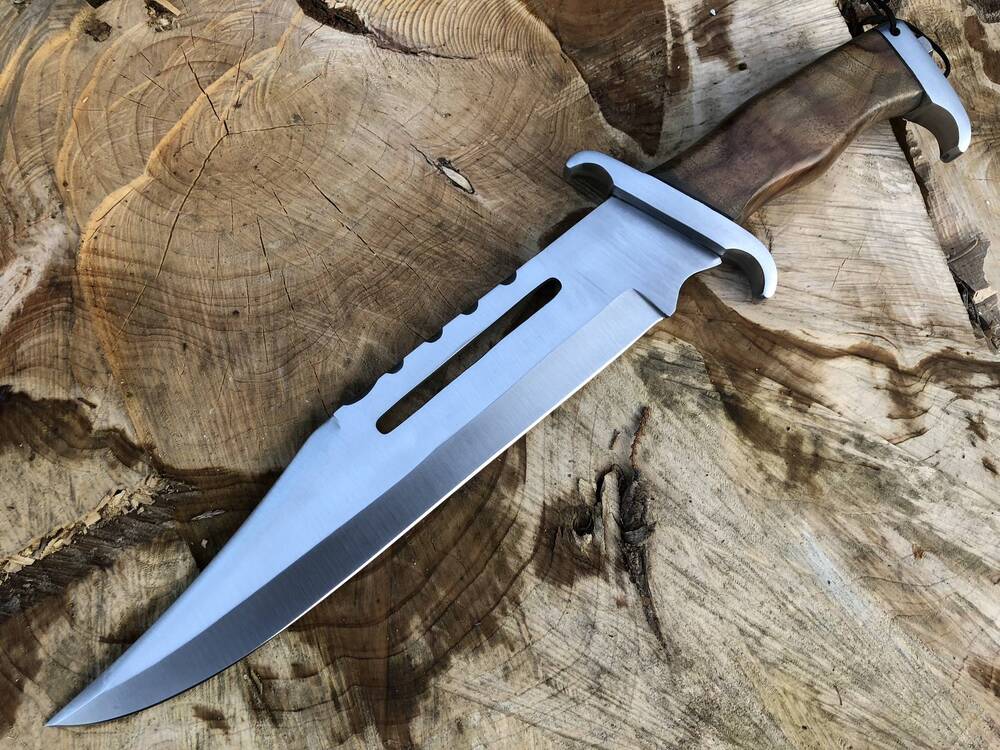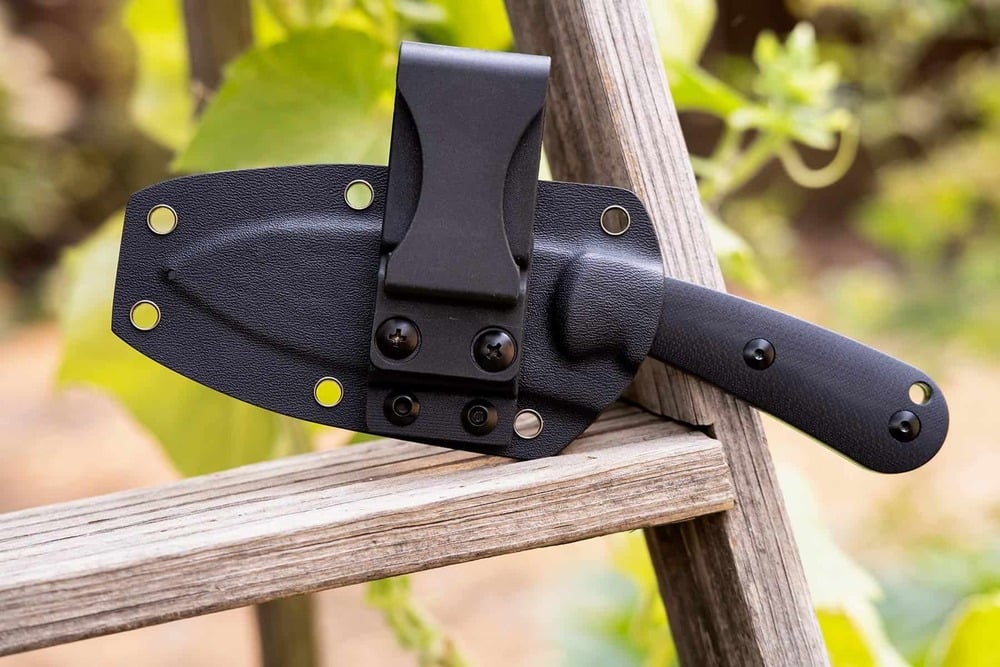
Last Updated on
For thousands of years, knives have been serving humanity, assisting people with whatever tasks they were pursuing. From the oldest stone blade used by ancient humans to modern fixed-blade designs, knives have been essential for a variety of tasks and professions. They say that if you have a knife, you have a solution. Unlawful applications aside, the potential uses of a knife are only limited by one’s imagination. There are plenty of knife designs, and each of them deserves a highlight, but today we will focus on fixed-blade knives.
Fixed blades offer countless benefits, from easy maintenance and sharpening to an impressive selection of styles. The possible applications are too beyond cunt. Whether you’re looking for a fixed-blade knife for hunting, self-defense, or everyday use, there are plenty of options to choose from – each with its own unique set of features. In this article, we’ll cover the benefits of owning a fixed-blade knife, examine different types of fixed knives and provide safety tips when working with them. We’ll also answer frequently asked questions so that you could stay as sharp as a brand-new knife.
Table of Contents
What is a Fixed-Blade Knife?
Types of Fixed-Blade Knives
Blade Styles
Edge Styles
Handle Styles
Things to Consider
Safety Tips
Conclusion
FAQs
What is a Fixed-Blade Knife?
Fixed-blade knives differ from other types of knives in their construction and structure. Unlike folding knives, fixed-blade knives are designed to be carried and used without requiring an additional opening or closing action. They are usually made from a single piece of metal with no moving parts and feature a strong, durable handle that provides a secure grip. Fixed-blade knives typically have thicker blades than other types and are designed for activities requiring more power and strength such as hunting, camping or outdoor use. However, they are perfectly capable of performing less demanding tasks.
Types of Fixed-Blade Knives
When it comes to сlassification, there are several common types of fixed-blade knives. They are usually classified according to blade style, edge style, and handle style.
Blade Styles
The most popular is the Bowie knife, which was invented by Jim Bowie in the early 19th century. It has a long curved single-edged blade, with a symmetrical cross section and a clip point on the end. A Bowie knife traditionally has a blade length of between six and twelve inches, but today you can find a variety of sizes. Other popular types include boot knives, camp knives, daggers and hunter’s knives.
Boot knives are small and usually carry on a belt or boot. They are typically single-edged, with a blade of around four inches in length. Unlike Bowie knives, they feature a spear point blade – a symmetrically-shaped blade with a point aligned with the centerline of the blade’s long axis.
Camping knives are designed for outdoor activities and feature blades ranging between four and eight inches. The blades are also typically made of stainless steel or carbon steel specifically designed to resist corrosion, making them perfect for outdoor use. Camping knives are often multi-purpose tools with additional features such as gut hooks and serrated edges providing even more utility while reducing the need to carry multiple knives.
Hunting knives are similar to camping knives, with the main difference being the blade length. The blades of hunting knives rarely exceed the four-inch threshold which allows the knives to remain effective tools for skinning and butchering game animals. The blades are also usually thicker and often feature a gut hook on the spine which makes it easier to quickly field dress or skin an animal after the hunt.
That list isn’t exhaustive. There also are various long-blade cutting tools like goloks and machetes and plentiful blades that are usually used as weapons. We won’t cover them lest our article should turn into a list of dozens of blade names.
Edge Styles
Fixed blade knives come in a variety of edge styles, each designed for different tasks. The most common styles are straight edge, serrated edge and scalloped edge.
Straight edges are best suited for slicing and cutting through softer materials like rope or food.
Serrated edges have a saw-like shape that makes them ideal for cutting through tougher materials such as wood or plastic.
Scalloped edges feature shallow indentations along the blade’s length that make them great for cutting through wet and sticky materials.
Handle Styles
Last but not least, the handle of a fixed knife. Just as important as the blade itself. It provides grip and control when using the knife for cutting or slicing tasks. Traditional full-tang handles offer good stability and strength, while half-tang handles are lighter and less expensive. Some handles also feature finger grooves or textured surfaces to provide additional grip when using the knife in wet conditions.
Materials are another important consideration. Knife handles can be made from various materials such as wood, metal, plastic or rubber. Micarta or KYDEX handles provide superior grip, even when wet or covered in blood or other liquids. Synthetic rubber grips are also available, offering padding and comfort during extended use. Handle materials such as wood, bone, antler or horn add a touch of classic and tradition to the knife while also providing a unique look and feel.
Things to Consider When Choosing a Fixed-Blade Knife
When choosing a fixed-blade knife it’s important to prioritize what you need a knife for rather than its appearance alone. Blades often look like pieces of art, and there is nothing wrong with following the urge to buy one, but it might fail to live up to your expectations. Besides, fixed-blade knives are an extremely versatile category of tools that can be used for anything from outdoor activities to cooking in the kitchen. By looking at key features like blade material, length, handle style and edge type, you’ll increase your chances of finding the perfect knife for any given task.
One of the most important features to consider when buying a fixed-blade knife is the type of blade material used. The strongest and most commonly used materials for blades are carbon steel, stainless steel and titanium. While carbon steel blades are generally considered the strongest option, they require more maintenance and care than stainless steel or titanium blades. If you are not too enthusiastic about having to constantly maintain the blade, opt for more undemanding materials.
The length of the blade also affects the way the knife performs certain tasks and can either facilitate or hinder the process. Generally speaking, short blades (3-4 inches) are better suited for finer tasks such as cutting small cordage, preparing food and skinning. Medium-length (4-6 inches) blades provide good overall utility with enough reach for larger tasks like slicing branches or carving wood. Longer blades (7 inches or more) offer great reach but may be difficult to control depending on their thickness and size.
Handle styles play an important role in overall comfort when using a knife. Traditional full-tang handles offer good stability and strength, while half-tang handles are lighter and less expensive. If you are choosing a knife for outdoor activities you might want a handle with finger grooves or featuring a textured surface. Those features ensure a more secure grip which will come in particularly handy when the weather is unfavorable.
Fixed-Blade Knife Safety Tips
Working with a fixed-blade knife, like with any other blade, comes with certain risks. It’s important to take the necessary steps to ensure you’re staying safe while using your knife. Here are some safety tips to keep in mind when working with a fixed-blade knife:
- Treat it seriously – Make sure you handle a knife with care and never point the blade toward yourself or others when using it. Consider purchasing protective gloves to further reduce the risk of cuts and other injuries.
- Maintain sharpness – Even if it might seem counterintuitive, keeping your blade sharp is essential for safety while using your knife. Dull blades require more force which can lead to slippage, increasing the chances of an accidental cut or injury. Regularly sharpen or hone your knives to ensure they remain razor-sharp at all times.
- Stay focused – It’s easy to get distracted while using a fixed-blade knife, so it’s important you stay focused on what you’re doing at all times. This will help prevent potential accidents if something unexpected happens while in use.
- Store them securely – Always make sure that your knives are stored securely when not in use, preferably in their sheaths or holders designed for their purpose. Doing so will help keep both you and those around you safe from unwanted contact with the blades which could result in serious injury.
By following these few simple tips, you’ll be able to enjoy working with your fixed-blade knife safely and confidently.
Conclusion
Fixed-blade knives are incredibly versatile tools that can be used for a variety of tasks. When considering which one to buy, it’s important to prioritize what you need from a knife rather than its appearance alone. Key features such as blade material and length, handle style and edge type should all be taken into account to ensure you find the knife that meets your needs. Remember – a knife is just a tool and poses no threat on its own. Follow the handling safety rules – and your knife will serve you well.
FAQs
What makes a fixed-blade knife unique from other types of knives?
A fixed-blade knife is unique from other types of knives because it has a single, solid piece of metal that forms the blade and handle. It does not have any movable parts, such as a folding mechanism or removable parts, and it is usually stronger and more durable than other knife types.
What are the different types of fixed-blade knives?
The different types of fixed-blade knives are almost impossible to count – so numerous they are. The most popular types include Bowie knives, boot knives, hunting knives, camping knives, skinning knives, filet knives and throwing knives. There is also a huge group of combat-oriented fixed-blade knives like daggers and kukris.
What are the advantages and disadvantages of a fixed-blade knife?
Fixed-blade knives are generally much stronger and more durable than folding knives due to their lack of moving parts and solid construction. They also come in a variety of styles and sizes, so you can find one for virtually any task. Unlike folding knives, fixed-blade knives don’t have a locking mechanism that can potentially fail, which could lead to accidental self-injury. That makes them relatively safer than other types of knives.
The primary disadvantages of a fixed blade knife are that they are more difficult to carry, as they require a sheath or other form of protective covering to safely transport. They are also slightly more difficult to clean, as the blade cannot be removed from the handle. Finally, they are typically heavier and bulkier than folding knives, which can make them less desirable for the outdoors.
How do you maintain a fixed-blade knife?
Maintaining a fixed-blade knife involves regularly cleaning and sharpening the blade. To clean the blade, use warm water and mild detergent to remove dirt and debris. Dry the blade with a soft cloth to prevent rust or corrosion. To sharpen the blade, use a sharpening stone or a sharpener such as those made by Warthog or Wicked Edge. Follow the instructions to ensure the blade is sharpened properly.
What are fixed-blade knives good for?
Fixed-blade knives are good for a variety of tasks, including hunting, camping, and general utility tasks. They are also popular for use in tactical and military operations, due to their durable construction and ability to be used in a variety of conditions.






Leave a Reply